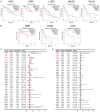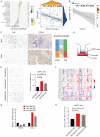Protocadherin-1 serves as a prognostic biomarker and promotes pancreatic cancer progression by suppressing CD8+ T cell infiltration through CCL5-CCR5 axis
- PMID: 38058826
- PMCID: PMC10695816
Protocadherin-1 serves as a prognostic biomarker and promotes pancreatic cancer progression by suppressing CD8+ T cell infiltration through CCL5-CCR5 axis
Abstract
Previous studies have shown that Protocadherins (PCDHs) enhance tumor proliferation, invasion, and metastasis; yet their role in pancreatic cancer (PC) progression and the tumor immune microenvironment remains unclear. This study aims to elucidate the role of PCDH1 in different cancer types, with a particular focus on its impact on immune suppression in PC. Utilizing data from TCGA, GTEx, and Gent2 databases, we assessed the expression of PCDH1 across various cancer types. The prognostic value of PCDH1 was demonstrated through Cox regression, Kaplan-Meier analysis, and ROC curve, while its relationship with gene mutations, tumor mutational burden (TMB), immune cell infiltration, and other clinical factors was investigated using Spearman correlation. Furthermore, the effect of PCDH1 on PC malignancy was experimentally validated by a series of in vitro and in vivo assays. Our results show a significant upregulation of PCDH1 in various tumor types, which is associated with poor prognosis, suggesting its potential application as an independent prognostic biomarker. Notably, in PC, PCDH1 exhibited significant associations with gene mutations, TMB, and immune cell infiltration. Clinical validations revealed a correlation between high PCDH1 expression and poor prognosis, coupled with a low level of CD8+ T cell infiltration. Furthermore, both in vitro and in vivo experiments confirmed the role of PCDH1 in promoting PC cell proliferation and migration while inhibiting CD8+ T cell recruitment through its modulation of CCL5-CCR5 axis. In conclusion, PCDH1 regulates the proliferation and migration of PC cells as well as CD8+ T cell infiltration in PC. PCDH1 may serve as a prognostic biomarker in multiple tumor types.
Keywords: CCL5; CCR5; CD8+ T cell; PCDH1; immune; pancreatic cancer.
AJCR Copyright © 2023.
Conflict of interest statement
None.
Figures








References
-
- Siegel RL, Miller KD, Fuchs HE, Jemal A. Cancer statistics, 2022. CA Cancer J Clin. 2022;72:7–33. - PubMed
LinkOut - more resources
Full Text Sources
Research Materials
Miscellaneous
